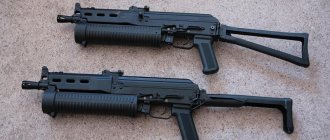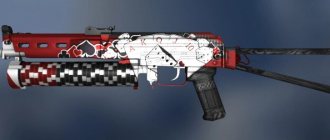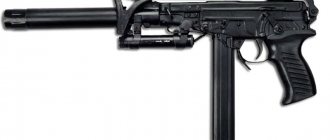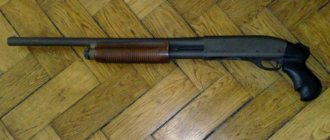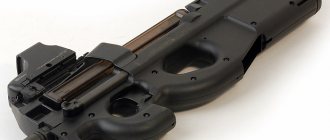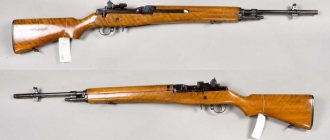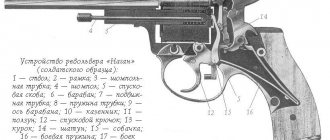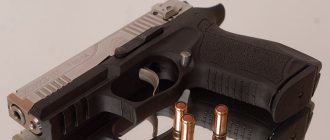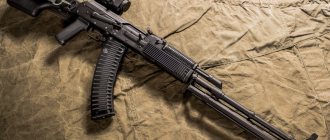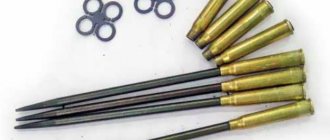Home | Weapons | Pistols | Germany | Heckler und Koch USP
HK USP pistol with attached tactical light and .45 ACP ammo
HK USP pistol chambered for .45 ACP
In 1993, Heckler und Koch introduced and put into mass production the USP pistol (Universal Selbstladen Pistole - a universal self-loading pistol), intended for use in the police, army, special forces, as well as ordinary citizens for self-defense and sports shooting. The design of this model began back in 1989. The head of the design work was Helmut Weldle. The purpose of the creation was a pistol that could be successfully used both in the police and army, and for self-defense by ordinary citizens, and could also be adapted to perform various tasks.
USP was planned to be sold mainly on the American arms market, so it was initially created for the new, rapidly gaining popularity in the United States, and very promising .40 S&W cartridge. The 9 mm pistols were based on the frame of the 40 caliber models and differed from them only in the barrel and magazine. In 1995, after the release of models chambered for .40 S&W and 9mm Parabellum, a version chambered for the American .45 ACP cartridge was introduced. Adapted for use by the Bundeswehr, the 9mm USP was adopted by the German Armed Forces that same year as the P8 (Pistole 8), where it remains in successful use today, earning a reputation as an extremely reliable and durable weapon. The P8 is in service with the famous special forces unit of the German Federal Border Guard - GSG9 (Grenzschutzgruppe 9). The army special forces KSK (Kommando Spezialkräfte) also adopted the P8.
USP pistols were adopted not only in Germany, but also by various law enforcement organizations and intelligence services in other countries of the world. For example, in the USA, USP is used by the Presidential Security Service - Secret Service, Immigration Service - INS, police departments of various states and army special forces. 9mm pistols are the most versatile, as they come in a huge variety of rounds, come in a wide variety of loadouts, and can be found all over the world. However, weapons chambered for the .40 S&W cartridge provide the best combination of such qualities as high stopping power of the bullet, acceptable dimensions, weight and recoil force. It should be noted that in Europe traditionally the most popular pistols are 9 mm, and in the USA - chambered for .40 S&W.
HK P8 pistol, Afghanistan, 2008
A US 7th Army Reserve Command soldier trains with his service P8
The 45-caliber USP is very popular in the United States, where the .45 ACP is preferred due to the highest stopping power of the bullet among the most common pistol cartridges, despite its significant dimensions and the impossibility of concealed carry under light clothing. The operation of the automation is based on the Browning design with a descending barrel, which enters with its rectangular protrusion, located above the chamber, into the window of the bolt-casing for ejecting spent cartridges, but the reduction itself here is carried out using a special part at the rear end of the return spring rod. This part is a recoil damping device and is equipped with a buffer spring. This solution makes it possible to reduce the recoil impulse and make the operation of the automation more tolerant of differences in the power of the cartridges used.
The barrel, made by cold forging on a rim, has a bore with polygonal rifling. Such a barrel has a long service life and minimizes the breakthrough of powder gases. The shutter-casing, made of chrome-molybdenum steel, is subjected to nitro gas treatment. Its coating is extremely resistant to corrosion. The frame is made of reinforced polymer and reinforced with steel inserts. The front part of the frame has grooves for attaching a tactical flashlight or laser designator. The trigger, magazine latch and safety levers, cover and magazine feeder are also made of polymer. The trigger mechanism is hammer-type, double-action, with safety cocking. The trigger force in single action mode is 2.5 kg, in self-cocking mode - 5 kg.
By replacing the locking plate, the trigger can operate in five different versions: double action - SA/DA (upper position of the safety lever - blocking, lower position - fire), while the safety lever in different versions can also serve as a safe release of the trigger when turning on the fuse or working only as a fuse; single action or self-cocking only - SA and DAO (the upper position of the lever is single action, the lower position is self-cocking only, while moving the lever to the lower position safely releases the trigger); single action - SA (the lever serves only to safely release the trigger); self-cocking only - DAO (without safety catch); Self-cocking only with safety catch. The lever, used for various purposes and operating modes of the trigger, can be located on either the left or right side of the frame. The weapon is equipped with an automatic firing pin safety, which prevents the firing pin from striking the cartridge primer until the trigger is fully pulled by the shooter.
USP Tactical pistol with attached PBS
HK USP Tactical Pistol
The bolt stop lever is located on the left side of the frame. A double-sided magazine release is located at the base of the trigger guard. To release the magazine, the shooter only needs to press the lever down with a natural movement of his thumb. The military P8's double-stack magazines are made of clear plastic to make it easier to control ammunition consumption. Sighting devices, consisting of a front sight and rear sight, fixed in dovetail grooves with the possibility of making lateral corrections, are equipped with white inserts to speed up aiming in the dark or in low light conditions. Pistols can also be equipped with an adjustable micrometric rear sight for sport shooting.
Warranty life - 25,000 shots. The resource, according to the experience of the owners, is about 110,000 shots. 9 mm pistols have a very long service life; they can withstand long-term shooting with particularly powerful hand-loaded cartridges and +P+, due to the fact that they are based on a variant chambered for the .40 S&W cartridge. After the USP pistols gained widespread popularity on both sides of the Atlantic, Heckler und Koch began producing various variants of the basic model, adapted for various highly specialized purposes, such as practical IPSC shooting or use in conjunction with a suppressor.
The pistol's few disadvantages include a manually controlled safety lever, which complicates the handling of the weapon, because an inexperienced or insufficiently trained owner may forget to turn it off in a critical situation. And the automatic firing pin safety function more than perfectly copes with the function of protecting against an accidental shot when the weapon is dropped. German USP pistols have extremely high reliability in harsh operating conditions and when using cartridges with a wide variety of equipment options, high service life and strength, excellent corrosion resistance, shooting accuracy, and very high quality materials and workmanship.
HK USP Compact pistol chambered for .40 S&W
HK USP Compact pistol chambered for .357 SIG and USP Compact 45 caliber
Introduced in 1997, the USP Compact has smoother contours of the bolt casing and frame, and has a reduced length and slightly modified trigger guard. These changes, combined with smaller dimensions and weight, make it possible to carry weapons concealed. The main change in the design is the absence of a buffer spring. However, to mitigate the impact of recoil, a plastic shock absorber bushing with a lifespan of 25,000 rounds is installed at the end of the return spring rod, which has a rectangular cross-section. The changes also affected the trigger mechanism. The trigger pull when firing with a pre-cocked hammer is 1.9 kg, with self-cocking - 4.3 kg. Trigger travel in single action mode has been reduced to 5.1 mm. In 1997, the USP Compact was adopted by the German police under the designation P10 (Pistole 10).
Owners about their USP Compact: “The impressions are good. The pistol is made very well, clearly with the army and police in mind. It fits in the hand very tightly, it seems like it was made for it, the sighting devices are clearly visible. At the same time, I must note that it is certainly easier to carry a Glock, although this may just be out of habit. Externally, USP Compact gives a more bulky impression. Very high accuracy when firing doublets.” “Very durable and amazingly reliable pistol. Made in the best German traditions for these qualities. But, unfortunately, it is complex in design, which is again typical of the German weapons school. Thousands of rounds fired and not a single delay. Works stably with different brands of cartridges, including cheap Wolf ones. Excellent accuracy. A friend didn’t like the handle, but for me it’s quite comfortable. Not everyone likes the design because of its angularity and massive bolt casing, but there is no arguing about tastes. The quality is excellent."
The USP 45 CT pistol was developed for use in US special forces as a highly effective compact weapon with the ability to mount a PBS. CT is short for Compact Tactical. Unlike the regular USP Compact, this pistol is equipped with a barrel with a protruding threaded muzzle, as well as large and high sights, which are necessary when using the weapon in conjunction with a silencer. The weapon comes with two magazines, a set of tools and cleaning accessories. Length: 196 mm; barrel length: 113 mm; height: 146 mm; width: 29 mm; weight: 780 g; Magazine capacity: 8 rounds.
Pistol HK USP 45 CT
Pistol HK USP 45 CT
According to the impressions of the owners, as well as people who have experience with the USP 45 CT model, the pistol “fits” perfectly in the hand, the holding is very comfortable, the “grip” is tight and stable. The weapon is also comfortable for people with large hands thanks to the magazine cover with a front lip. The large bolt casing, safety levers and bolt stop are easy to manipulate without any problems. However, with thick gloves it can be somewhat difficult to work with the magazine release levers due to their small dimensions, but it should be clarified that this is a problem with most combat pistols, and not just this model. After shooting, the 45 CT leaves only positive impressions.
Firstly, when firing there is no strong recoil, which is perceived here as smooth, without sharpness, with a slight bounce of the barrel. Secondly, a comfortable grip significantly reduces the impact of recoil and greatly helps control the pistol during high-speed shooting. Aimed shooting at a short distance is comparable to the results of a standard USP of the same caliber, which is facilitated by an elongated barrel, again a comfortable handle shape and a smooth, not long trigger stroke. The weapon is certainly well suited for high-speed burst shooting and “instinctive” offhand shooting. Reliability, as always, for pistols of this model range from Heckler und Koch is beyond praise. It’s not even worth mentioning the high resistance of the coating to corrosion and abrasion, as well as stability of operation under harsh operating conditions.
The pistol fires without delay with cartridges of a wide variety of equipment and from any manufacturer, even the cheapest. As for wearing, not everything is clear. Although the model is called Compact, the pistol is actually quite large, but not particularly wide. 45 CT, designed for concealed carry, however, it will unmask itself under light clothing and in countries with warm climates it is recommended to be carried in a special belt bag. If you wear it under a sweater, light jacket or other loose clothing, there will be no problems with concealment. The gun is comfortable to carry, does not cling to anything when removing it and does not become a burden when performing usual work. Overall, the USP 45 CT is an excellent choice for a person who wants to have a pistol that is effective in shooting and influencing the enemy, more than accurate enough in shooting, extremely reliable, does not require very careful and long-term maintenance, is comfortable to carry and is simply pleasant to use. fire.
Pistol USP Heckler und Koch cartridge, caliber. Device
Heckler & Koch USP (German: Universelle Selbstlade Pistole - universal self-loading pistol) - developed by the German company Heckler & Koch. First introduced in 1993. Designed to arm the police and army. It is distinguished by high survivability and reliability, good shooting accuracy. The disadvantages include the significant size of the weapon, even in the compact version, a rather high center of gravity and a massive bolt, which makes concealed carry somewhat difficult.
Usage
HK USP Map of the World
- Ireland
- Italy: HK USP SD in service with the 17th Special Operations Wing of the Italian Air Force
- USA: (US Army Special Forces, SEALs, 75th Ranger Regiment, etc.)
- Denmark
- Hungary
- Poland: (HK USP SD (with muffler attachment) Jednostka Wojskowa Komandosów, JW GROM, Jednostka Wojskowa Agat, Jednostka Wojskowa Nil)
- Switzerland
- Ukraine: in service with Group “A” of the Special Operations Center of the Security Service of Ukraine
- Germany
- France
- Estonia: in the summer of 2005, an agreement was concluded on the purchase of a batch of 9-mm H&K USP pistols, adopted by the Estonian armed forces
- Japan
HK USP pistol - video
At the turn of the 80s–90s. XX century The German once again tried to create a “universal pistol” that would meet the requirements of the army, police, and special forces. The model, introduced in 1993, was designated USP - Universal Selbstladen Pistole, that is, “universal self-loading pistol.” Its development was led by experienced designer H. Weldl. The pistol was designed for 9x19 Parabellum and .40 Smith & Wesson cartridges; later a version was introduced for the .45 ACP cartridge.
HK USP pistol chambered for .45 ACP
The automatic operation of the pistol operates according to the recoil pattern of the barrel with a short stroke; locking and unlocking of the barrel bore is carried out by rocking the breech of the barrel. At the same time, in contrast to the classic “Browning High Power” scheme, the barrel is lowered not by a rigid frame pin, but by a spring-loaded hook at the rear end of the return spring rod, which moves during the movement of the moving system. This allows you to soften the effect of recoil on the weapon, and also, according to the developers, ensures that the automation operates with a significant difference in the pressure of the powder gases in the channel. Thus, the automation remains operational when using cartridges of various equipment, including reinforced ones. Locking is accomplished by engaging the protrusion of the breech of the barrel with the groove of the bolt window, which simplifies the shape of the bolt.
The barrel with polygonal rifling is made by cold forging. External metal surfaces are treated with anti-corrosion coating. The pistol frame is made of molded fiberglass reinforced plastic with steel inserts at the top. The shape of the trigger guard is designed for a two-handed grip, the size of the guard is designed for shooting with thick gloves. The grooves on the front of the frame are used for attaching a laser pointer, illuminator, etc.
HK USP 9 mm pistol
The trigger mechanism with a semi-hidden trigger is equipped as standard with a safety lever, which also plays the role of a safety release lever. However, the characteristic features of USP include the ability to change the nature of the mechanism’s operation by replacing a special plate in the trigger mechanism. There are five possible options for its operation: – when the flag is in the upper position, shooting is possible with preliminary cocking of the hammer, when in the lower position, only self-cocking is possible; – flag positions - “safety” (with a safe release) and “double action” (firing with pre-cocking or self-cocking); – flag positions - “safety” (without safe release) and “double action”; – flag positions - “self-cocking shooting” and “safety”; – shooting only with preliminary cocking of the hammer, the flag serves only for the safe release of the hammer; – shooting only by self-cocking, the checkbox is unchecked. Since the checkbox can be located on the right or left, there are up to ten options for working, providing for the requests of different user groups. Only a qualified technician can change options. There is an automatic safety lock that blocks the firing pin until the trigger is fully pressed.
The cartridges are fed from a two-row detachable magazine. The double-sided magazine release lever is located behind the trigger guard. The sighting device is equipped with white inserts for shooting in low light conditions.
The USP modification with conventional barrel rifling and a double-action trigger mechanism with a safety catch was adopted by the Bundeswehr under the designation P8. A modification of the USP Compact under the designation P10 entered service with the German Federal Police. USP pistols were also sold to Hungary, Denmark, Ireland, Italy, Poland, France, Switzerland, Estonia, Japan, and Ukraine. USPs are also popular in the civilian market.
In Russia, the 9-mm USP Compact pistol was included in the number of foreign weapons accepted for arming internal affairs agencies in 2006.
design details
A German Army soldier demonstrates the MP7A1 in the IDZ program
The MP7 uses the gas system that is used in H&K's G36 and HK416 assault rifles, instead of the blowback system traditionally seen on sub-machine guns including the H&K. The 30mm 4.6× ammunition is exclusively for the pistol and offers low recoil. This ammunition is unique among submachine guns in that the bullet is made almost entirely of hardened steel penetrator instead of soft copper or lead.
The MP7 allows a conventional 20-, 30-, or 40-round magazine box to be mounted in a pistol grip (a 20-round magazine is comparable in size to a 15-round magazine in a 9×19mm magazine, while a 40-round magazine compares to a 30-round magazine) go round 19mm magazine at 9×). It has a mirror-symmetrical fire selector, bolt catch lever and magazine release. It has a retractable rod and a folding front clutch (MP7 and MP7A1 variants, MP7A2 lacks a folding front clutch); it can be fired either with one hand or with both hands. It is compact and lightweight, thanks to the use of polymers in its construction.
The MP7 has a cyclic rate of fire of 950 rounds per minute (RPM).
ammunition
The MP7's specially designed armor-piercing (AP) high-velocity rounds consist of either a copper-plated solid steel (DM11), an alloy-coated steel jacket (DM21), or a copper-alloy jacketed lead core bullet (Fiocchi FMJ ZP). The DM11 (Final Combat) high velocity AP standard, round in shape with a 2.0 g (31 g) projectile, has a muzzle velocity of 720 m/s (2,362 ft/s) and has a muzzle energy of 506 J (373 ft lbf) . DM11
round penetrates a CRISAT NATO target (20 layers of Kevlar with 1.6 mm titanium backing) at 200 m. Rounds have a small diameter, allowing for double the penetration capabilities and high productivity in a very small magazine.
Belgium's VBR produces a 4.6×30mm two-piece controlled fragmentation projectile that is claimed to increase permanent wound cavity content and double the chance of hitting a vital organ. Heckler & Koch states that the CPS Black Tip ammunition made by FIOCCHI has a muzzle energy of approximately 525 J, which would be comparable to 9×19mm Parabellum cartridges.
accessories
The MP7 has a full-length, top-mounted Picatinny rail that comes standard with folding nose and rear sights included. When the sights fold, they resemble the Patridge style. Folded, they have . The sights can be easily removed by loosening one screw and lifting them up. It can accommodate additional rails on the sides of the barrel, which allow it to mount commercial optical sights (telescopic and red dot sights), laser designation modules (LAM), and tactical flashlights. It can also accept a suppressor, and its custom suppressors do not interfere with its accuracy and rate of fire.
Modifications
One of the distinguishing features of the USP is the wide variety of modifications of this weapon. There are currently nine different options. These options usually have one system. The safety box, slide stop and magazine eject button can be installed either on the left or on the right (for left-handed shooters) at the customer's request. The trigger guard has a protrusion for the finger of the second hand when shooting with both hands. On the frame of the pistol, under the barrel, there are guides for attaching a combat flashlight or laser target designator. The pistol's design makes extensive use of polymers (the pistol's magazine is also made of polymer, except for the USP .45, which has a steel magazine).
Mk23 - combine for SOCOM
Pistol MK23 Mod 0 .45 cal SOCOM
In 1989, US Special Operations Command (US SOCOM) announced a program to create a holster-worn "offensive sidearm." The requirements included a complex that included a family of 11.43 mm cartridges, a self-loading pistol, a silencer and a “sighting block”. It was planned to assemble two main options: “assault” (pistol + “sighting block”) and “stalking” with the addition of a silencer. In 1995, SOCOM chose a pistol created by Heckler und Koch based on the USP. The pistol was put into service under the designation Mark 23 Model 0. The main differences of the Mk23 were the elongated barrel and bolt, the muzzle of the barrel protruding from the bolt - for installing a muffler, mount for the sighting unit and controls. The chamber bevel is profiled so as not to cause sticking when feeding a cartridge with any bullet configuration. The treatment of metal parts should protect the gun from corrosion when immersed in sea water. The trigger mechanism operates in the “double action safety” version. The sight and front sight are raised so that the installed silencer does not block the aiming line. The “Aiming Unit” (LAM) combines the functions of a flashlight-illuminator and a laser target designator, which can use a laser emitter in both the visible range and infrared. The weapon turned out to be quite bulky - without a silencer, the Mk23 Mod0 pistol weighs 1.2 kg, with a silencer and an equipped magazine - 1.92 kg.
USP Compact
HK USP Compact pistol
A smaller modification of the USP pistol. Appeared in 1993. It differs from the basic version in a smaller magazine, as well as smaller dimensions.
P2000
Pistol HK USP P2000
Pistol HK USP Р2000SK
The P2000 is a further development of the USP Compact. The main differences from previous USP pistols are improved ergonomics, replaceable pistol grip panels and a modular trigger system, which received a proprietary designation - Combat Defense Action (CDA). Along with this, the basic modification of the P2000 pistol is equipped with a safety release lever for the cocked pistol. The lever is located on the back of the frame, to the left of the trigger.
USP Compact Tactical
USP Compact Tactical Pistol
An upgrade to the HK USP Compact that includes threads for suppressors on the outer barrel.
USP Tactical
HK USP Tactical Pistol
It is a modification of the HK USP for police use. The main difference from the standard USP is the possibility of using a silencer. A USP-S version was also released with a smaller magazine capacity of 12 rounds.
USP Expert
Pistol HK USP Expert .45 ACP
It has an extended barrel and increased magazine capacity - 18 rounds of 9 mm Para, 16 rounds of .40 S&W or 12 rounds of .45 ACP. This variant is intended primarily for participation in International Practical Shooting Confederation (IPSC) competitions.
USP Elite
Pistol HK USP Elite
Modification of HK USP Expert with an extended barrel and bolt.
USP Match
Pistol HK USP Match
Sports option. It has a special attachment that reduces barrel bounce when shooting due to its weight. Out of production since 1999.
testing
Because the USP was developed at the same time as the SOCOM MK23, the pistol underwent much of the same rigorous testing.
Cold forged chrome steel barrel for increased service life. USP barrels shipped November 1994 use beveled rifling, while 1994 and earlier models use traditional "ground and groove" rifling. During testing, the bullet was deliberately fed in a USP barrel. Another cartridge was then fired into the interfering bullet. The second bullet cleared the barrel, causing a barely noticeable thickening. The pistol was then fired for accuracy and the resulting group measured less than 4 inches at 25 meters. Temperature testing required by USP to be frozen to -42°C and fired, frozen again, and then heated to 67°C and fired. These temperature tests are continuously repeated without any adverse effects on USP.
The pistol was also subjected to NATO MIL-SPEC mud and rain testing, which passed without issue. Immersion and salty splashes also do not cause any problems. German Navy combat divers used the USP for two years without any signs of corrosion.
Safety testing exceeded the ANSI/Sami requirement adopted in May 1990 and included dropping the USP with a primed cartridge and hammer on the hammer released on various hard surfaces without discharging. The USP exceeded these commercial requirements as well as German army and police tests, including repeated six-foot (1.8 m) drop tests, the former's hammer, on a steel-supported concrete slab. Proof round firing results in no cracks, deformations, or increased head space. Attempts to fire the USP pistol with the breech unlocked were unsuccessful.
Testing with a variety of ammunition has proven USP meets these high standards. During the USP testing phase, the recoil reduction system was shown to reduce USP grip force to approximately 300 newtons (67 lbf). Peak impact force on competing .40 caliber polymer and metal framed pistols was about 5,000 newtons (1,100 lbf). The main benefit of low peak shock is reduced wear on pistol components, a big concern with the +P cartridge in 9mm, .40 S&W and .45 ACP. Reducing peak impact forces also contributes to softer recoil for shooters, although their "felt bounce" values are much more subjective.
Photos of HK USP pistols
Similar
AK-47 assault rifle cartridge caliber 7.62 mm.
Device. Rate of fire AK-74 assault rifle cartridge 5.45 mm caliber. Device. Rate of fire
Dragunov SVD sniper rifle caliber 7.62 mm. Device
AKS-74U assault rifle cartridge caliber 5.45 mm. Device. Weight
Mauser K96 pistol cartridge caliber 7.63 and 9 mm. Device
Pistol Walter PP / PPK cartridge caliber 7.65 and 9 mm. Device
Pistol Yarygin PYa Grach cartridge caliber 9 mm. Device
DShK machine gun cartridge caliber 12.7 mm. Device. Rate of fire
Luger pistol R.08 Parabellum cartridge caliber 9 mm. Device
Pistol PM cartridge caliber 9 mm. Rate of fire. Dimensions. Bullet speed. Sighting range
Self-loading shotgun Saiga-12 cartridge, caliber. Device
Maxim machine gun cartridge caliber 7.62 mm. Device. Weight
PPSh-41 Shpagina submachine gun cartridge caliber 7.62 mm
APS Stechkin pistol cartridge caliber 9 mm. Device
Nagan system revolver cartridge caliber 7.62 mm. Device
Kalashnikov PK machine gun and PKM cartridge caliber 7.62 mm. Device
Simonov carbine SKS-45 cartridge caliber 7.62 mm. Device
Rifles and carbines Mauser 98 caliber 7.92 mm. Device
PPS-42 and PPS-43 Sudaev submachine gun cartridge caliber 7.62 mm
Pistol Walter P38 cartridge caliber 9 mm. Device
MP-40 German submachine gun cartridge caliber 9 mm. Device
VSS Vintorez sniper rifle caliber 9 mm. Device
Submachine gun PP-91 Kedr cartridge 9 mm caliber. Device
Light machine gun RPK-74 cartridge caliber 5.45 mm. Device
Pistol Glock 17 cartridge caliber 9 mm. Device
Makarych, Izh-79-9T, MR-79-9TM, MP-80-13T traumatic pistol
AK-12 assault rifle cartridge caliber 5.45 mm. Device. Weight
Mosin rifles and carbines Three-line caliber 7.62 mm
PMM Makarov pistol modernized 12 rounds. Device
Revolver Colt Single Action Army (SAA) Peacemaker. Device
Machine gun PKP Pecheneg cartridge caliber 7.62 mm. Device
Sniper rifle VSSK Exhaust caliber 12.7 mm. Device
Beretta pistol 92 cartridge caliber 9 mm. Device
TT - Tokarev pistol cartridge caliber 7.62 mm. Device
Submachine gun PP-19 Bison cartridge caliber 9 and 7.62 mm. Device
Sniper rifle SV-98 caliber 7.62 mm. Device
Vladimirov KPV machine gun cartridge caliber 14.5 mm. Device
ASH-12 assault rifle cartridge caliber 12.7 mm. Device. Rate of fire
PSM pistol cartridge caliber 5.45 mm. Device
Pistol Colt M1911A1 cartridge caliber 45. Device
Smith-Wesson revolver Russian cartridge, caliber 10.67 mm. Device
Degtyarev DP-27 light machine gun, 7.62 mm caliber cartridge. Device
Shotgun Mossberg 500 Cartridge. Dimensions. Rate of fire. Sighting range
Pistol USP Heckler und Koch cartridge, caliber. Device
Thompson submachine gun cartridge caliber 11.43 mm. Device
Hunting carbine OSK-88 (SVT-40) caliber 7.62 mm. Device
AS Val silent automatic cartridge caliber 9 mm. Device
Submachine gun PP-19-01 Vityaz cartridge 9 mm caliber. Device
Machine gun Kord cartridge caliber 12.7 mm. Device. Weight. Sighting range
Osa - traumatic pistol cartridge, caliber. Device
AK-9 assault rifle cartridge caliber 9 mm. Device. Rate of fire
Degtyarev RPD light machine gun, 7.62 mm caliber cartridge. Device
Automatic OTs-14 Groza cartridge caliber 9 mm and 7.62 mm. Device
Czech pistol CZ-75 (modifications). Device
Browning pistol 1903 cartridge caliber 9 mm. Device
Sniper rifle OSV-96 caliber 12.7 mm. Device
FN P90 submachine gun cartridge caliber 5.7 mm. Device
Submachine gun OTs-02 Cypress cartridge caliber 9 mm. Device
Sniper rifle ASVK Kord caliber 12.7 mm. Device
Automatic AEK-971 Cartridge. Caliber. Device. Rate of fire
Steyr AUG assault rifle (A1, A2, A3) cartridge caliber 5.56 mm
AK series 100 assault rifles. Modifications. Device. Weight. Dimensions
Uzi submachine gun. Cartridge. Caliber. Rate of fire
Pistol SR1M Gyurza cartridge caliber 9 mm. Device
Pistol GSh-18 cartridge caliber 9 mm. Device
SVDK sniper rifle caliber 9.3 mm. Device
Automatic SR-3M Whirlwind cartridge caliber 9 mm. Device
Machine gun NSV-12.7 Utes cartridge, cal. Device. Weight
Kalashnikov RPK light machine gun cartridge caliber 7.62 mm. Device
Sniper rifle VSK-94 caliber 9 mm. Device
Vostok-1 (Jorge-3M) 9mm caliber traumatic pistol. Device
Degtyarev PPD submachine gun cartridge caliber 7.62 mm
English sniper rifle L96A1 cartridge, caliber
M1 Garand rifle cartridge caliber 7.62 mm. Device
Desert Eagle pistol. Device
Smith-Wesson revolver (modifications). Device
Automatic rifle HK G36 (E, K, C, KE) cartridge caliber 5.56 mm
Pistol P-96 cartridge caliber 9 mm. Device. Rate of fire
Pistol GP35 Browning High Power cartridge, caliber. Device
Assault rifle FN SCAR (L, H) cartridge caliber 5.56 and 7.62 mm
Revolver Lefoshe M1856 cartridge caliber 11 mm. Device
Submachine gun PP-90 cartridge caliber 9 mm. Device
AN-94 Abakan automatic Nikonov cartridge caliber 5.45 mm. Device
Submachine gun PP-2000 cartridge caliber 9 mm. Device
Mauser pistol HSc cartridge caliber 7.65 and 9 mm. Device
M16 automatic rifle cartridge caliber 5.56 mm. Device
Fedorov assault rifle cartridge caliber 6.5 mm. Device. Rate of fire
Pistol Baltiets cartridge caliber 7.62 mm. Device
Strizh pistol cartridge caliber 9 mm. Device. Weight. Sighting range
Browning pistol 1910 cartridge caliber 7.65 and 9 mm
Silent pistol PSS Vul cartridge caliber 7.62 mm. Device
Pistol SIG-Sauer P226 cartridge caliber 9 mm. Device
Pistol OTs-27 Berdysh cartridge caliber 7.62 mm and 9 mm. Device
AK-107 assault rifle cartridge caliber 5.45 mm. Device. Rate of fire
OTs-44 sniper rifle, caliber 12.7 mm. Device
German machine gun MG3 cartridge caliber 7.62 mm. Device
Self-loading shotgun Browning Auto-5 cartridge, caliber. Device
Submachine gun AEK-919K Kashtan cartridge caliber 9 mm. Device
PB pistol silent cartridge 9 mm caliber. Device
Pistol OTs-33 Pernach cartridge caliber 9 mm. Device
Hunting carbine KO-98 cartridge caliber 7.92 mm. Device
TK (Korovin pistol) caliber 6.35 mm. Device. Weight. Dimensions
Underwater assault rifle APS cartridge caliber 5.66 mm. Device
Pistol OTs-21 Malysh cartridge caliber 9 mm. Device
American M60 machine gun, 7.62 mm caliber cartridge. Device
MTs-116M sniper rifle, caliber 7.62 mm. Device
Automatic 9A-91 cartridge caliber 9 mm. Device. Rate of fire
Submachine gun PP-93 cartridge caliber 9 mm. Device
VAG-73 - Gerasimenko pistol. Device. Weight. Dimensions
Cordon-5 is a traumatic pistol. Device. Weight. Dimensions
Goryunov SG-43 heavy machine gun cartridge caliber 7.62 mm. Device
Webley revolver cartridge, caliber. Device. Dimensions. Weight
Machine gun AEK-999 Badger cartridge caliber 7.62 mm. Device
RP-46 machine gun, 7.62 mm caliber cartridge. Device. Rate of fire
Sniper rifle VS-8 cartridge caliber 8.6 mm. Device
Slostin machine gun cartridge caliber 7.62 mm and 14.5 mm. Device
Assault rifle Tavor TAR-21 cartridge caliber 5.56 and 5.45 mm
Submachine gun SR-2 Veresk cartridge caliber 9 mm. Device
Lancaster pistol cartridge caliber 12.1 mm. Device. Rate of fire
Submachine gun PP-90M1 cartridge caliber 9 mm. Device
Underwater pistol SPP-1M. Device. Weight. Dimensions
Traumatic pistol MP-461 Guard. Device. Weight. Dimensions
Lebel rifles and carbines are cartridgeed in 8 mm caliber. Device
Automatic A-91 cartridge caliber 7.62 mm. Device. Rate of fire
M14 automatic rifle cartridge caliber 7.62 mm. Device
Revolver Smith & Wesson Model 10 Military & Police
Automatic rifle FN FAL cartridge caliber 7.62 mm. Device
Submachine gun STEN MK 2. Device. Weight. Dimensions
Traumatic pistol IZH-78-9T Chain mail cartridge caliber 9 mm
Leader-M traumatic pistol 11.43×32T. Device. Weight. Dimensions
Ingram M10 and M11 submachine gun. Device. Weight. Dimensions
Pistol Steyr M9-A1 cartridge caliber 9 mm. Device. Weight
Pistol OTs-23 Dart cartridge caliber 5.45 mm. Device
Berthier rifles and carbines caliber 8 mm. Device
Automatic shotgun USAS-12 cartridge caliber 18.5 mm
Sniper rifle VS-121 caliber 7.62 mm. Device
Traumatic pistol MP-353 cartridge, caliber 11.43 mm
Tiss machine gun cartridge caliber 9 mm. Device. Rate of fire
Traumatic pistol MP-355 cartridge caliber 9 mm. Device
Automatic double-medium ADS cartridge caliber 5.45 mm. Device. Rate of fire
Traumatic pistol MP-81 cartridge caliber 9 mm. Device
Pistols Zastava 70 and 70(k), cartridge caliber 7.65 or 9 mm. Yugoslavia
Sniper rifle GALATZ (Galil) cartridge caliber 7.62 mm
Pistol MP-444 Bagheera cartridge caliber 9 mm. Device
Revolver Colt New Army / Navy. Device. Bullet speed. Sighting range
Type 64 is a Japanese automatic rifle. Device
HK45 - Heckler & Koch
The HK45 was developed as a product improvement of the highly regarded USP45, first released in the 1995. The Caliber .45 ACP HK45 includes several user-inspired enhancements including changeable grip panels (backstraps), a Picatinny MIL-STD-1913 accessory rail, better ergonomics, and more ambidextrous controls.
Along with the HK45 Compact, the HK45 was developed as a possible candidate for the Joint Combat Pistol (JCP) and Combat Pistol (CP) programs administered by the US military in their search for a new service handgun to replace the 9-millimeter M9. These programs were suspended before completion and no pistols were selected.
The HK45 uses an HK proprietary O-ring barrel for precise barrel-to-slide lockup and optimal accuracy. HK45 barrels are made using the famous HK cold-hammer forging process for superior performance.
45 ACP ball through +P ammunition, the HK45 combines the accuracy, modularity, reliability and minimum 20,000 round service life of the famed USP45 series with the improved ergonomics of the P2000 series pistols.
HK45 models can also be fitted with threaded barrels for use with muzzle mounted sound suppressors.
Each HK45 comes standard with an extra backstrap; medium and small interchangeable backstraps ensure an optimal fit for most shooter's hands and complement the ergonomic profile grip.
An improved USP-style control lever, a combination safety and decocking lever, is frame mounted on the HK45 and is quickly accessible. The HK45 control lever has a positive stop and returns to the “fire” position after decocking.
By using the modular approach to the internal components first pioneered by HK on the USP, the control lever function of the HK45 can be switched from the left to the right side of the pistol to accommodate left-handed shooters (additional parts required).
Left and right mounted control levers provide safety and/or decocking functions as required and can be fitted to the pistol simply by changing parts. For true ambidextrous use, a control lever can also be mounted on both sides of the pistol if required.
Well-suited for personal defense use, the HK45 is available in, or can be converted to, a wide variety of variants that use different trigger firing modes, including double action/single action (DA/SA) and DAO (double action only) . The DAO mode uses the unique Heckler & Koch LEM (Law Enforcement Modification) firing system for improved double action trigger pull.
- AVAILABLE CONFIGURATIONS
- Part No. 745001‐A5, UPC 642230244702 – HK45 (V1) DA/SA, safety/decocking lever on left, with two 10rd mags – MSRP $849
- Part No. 745001LE‐A5, UPC 642230245167 – HK45 (V1) DA/SA, safety/decocking lever on left, with three 10rd mags with night sights – MSRP $949
- Part No. 745007‐A5, UPC 642230245754 – HK45 (V7) LEM DAO, with two 10rd mags – MSRP $849
- Part No. 745007LE-A5, UPC 642230246805 – HK45 (V7) LEM DAO, with three 10rd mags with night sights – MSRP $949
Options
Recent production MP7A1 (note trigger safety) with Zeiss RSA reflex red dot sight on display as part of Germany's IDZ program.
- PDW
: The first prototype was shown in 1999 and was designated "PDW" (Personal Defense Weapon). It had a short Picatinny rail on the top and a smooth surface pistol grip. - MP7
: In 2001, it was designated "MP7" and went into production. Changes include a full length Picatinny rail, a thick curved stock and an anti-slip surface on the pistol grip much like the HK USP. It also has folding sights mounted on a Picatinny rail and the button for folding the handguard has been made larger for easier operation. - MP7A1
: In 2003, its designation was changed to "MP7A1" and featured a redesigned pistol grip with a different surface and curved shape, a smaller stock with a straight buttpad, side Picatinny rails as standard, and folding sights were made more compact. The weapon was made a little longer, but because the stock was reduced, the overall length did not change. The stock can also be locked in 3 positions. Latest MP7A1 models have a trigger safety similar to a Glock pistol; The middle part of the trigger must be removed before the outer part can move. This will help stop random discharges if the trigger is stuck. - MP7A2
: Option without a folding front handle, but has a Picatinny rail to mount various handles according to user preference. - MP7-SF
: Semi-automatic only variant of the MP7 which is currently used by the Ministry of Defense Police in the United Kingdom.
Tests
The Heckler & Koch Mk 23 mod 0 pistol, which is a reinforced modification of the USP, has proven itself excellently in comparative tests, where its characteristics were able to outperform pistols of other brands. It fired 30,000 rounds of high-powder cartridges (certified to use .45ACP P+ ammunition) without much difficulty. This weapon also passed the firing test at −50 °C and at +73 °C, without lubrication, after four days in salty sea water and after testing the sun, dust and dirt. He could shoot even after falling onto a concrete floor from a height of three meters. Some have called this pistol "the most thoroughly tested weapon in the military history of the United States."
users
| A country | Name of the organization | model | caliber | Link |
| Australia | Australian Federal Police Air Security Officers | – | 9mm | |
| Western Australia Police | USP Tactical | +0,45 | ||
| Australian Army Tactical Assault Group East and West | USP Tactical | – 9mm | ||
| Queensland Police Special Emergency Response Team | – | – | ||
| Victoria Police Special Task Force | – | – | ||
| Denmark | Danish police | USP Compact | 9 mm | |
| Jægerkorpset of the Royal Danish Army | USP9 SD | 9 mm | ||
| Egypt | Central Security Forces | – | ||
| Estonia | Estonian Armed Forces | USP | 9 mm | |
| France | French Navy (PA HK Marine) | USP Compact | – | |
| Recherche Aéroportée et Actions Spécialisées (Rapace) | USP Tactical | – | ||
| Germany | Bundeswehr | P8 USP Tactical (P12) | 9 mm (P8), 0.45 (P12) | |
| Landespolizei | USP Compact (P10) | – | ||
| Georgia | Georgian armed forces | USP | 9 mm | |
| Greece | Greek Coast Guard | USP Compact | 9mm | |
| Greek police | USP Compact | 9mm | ||
| Ireland | defense forces | family USP | 9mm | |
| Japan | Japanese Special Forces Group | – | – | |
| Libya | – | .40 S&W .45 ACP | ||
| Lithuania | Lithuanian Armed Forces | – | 9mm | |
| Luxembourg | Unité Spéciale – de la police of the Grand Duchy of Police | – | – | |
| Malaysia | Pasukan Gerakan Khas (PGK) from Royal Malaysia Police | USP Compact USP Tactical SD | 9mm | |
| Royal Malaysia Police units in the States of Sabah and Sarawak | USP Compact | |||
| Malaysian Immigration Department | ||||
| Grup Taktikal Khas (GTK) from the Malaysian Immigration Department | ||||
| RELA housing | ||||
| Mauritius | Military Mauritius | P8 USP Tactical (P12) | 9 mm (P8), 0.45 (P12) | |
| Pakistan | Inter-Services Intelligence | family USP | – | |
| Poland | Grupa Reagowania Operacyjno-Manewrowego (GROM) from the Polish Special Forces | family USP | – | |
| Portugal | Public Security Police | family USP | – | |
| Republican National Guard | family USP | – | ||
| Portuguese Air Force | family USP | 9mm | ||
| Portuguese jailer | family USP | – | ||
| republic of china | Special Forces , | USP | 9mm | – |
| Serbia | Special brigade | USP | 9mm | |
| Singapore | Special Operations Command of the Singapore Police Force | USP Compact | – | |
| Special Working Group (STF) of the Central Narcotics Bureau (CNB) | – | – | ||
| South Africa | South African Police Service Special Working Group | USP USP Compact | 9mm | |
| Spain | Spanish Armed Forces | – | – | |
| Grupo Especial de Operaciones (GEO) in Cuerpo Nacional de Policia | USP Compact | – | ||
| Servicio de Vigilancia Aduanera | USP Compact. | – | – | |
| Guardia Civil | USP Compact | – | ||
| Mossos Esquadra (PGR) | USP Compact | – | ||
| Thailand | Royal Thai Army | USP | +0.45 ACP | – |
| United States | Federal Flight Deck Officer (FFDO) | USP40c | .40S&W | |
| Maine State Police | USP45 | +0.45 ACP | ||
| Santa Monica Police Department in California | USP45 USP9 | +0.45 ACP 9mm | ||
| Immigration and Naturalization Service | USP Compact/LEM | .40S&W |
Equipment
USP45 with unmistakable mounting light
The USP has an accessory rail on the front of the frame that allows attachments to aftermarket equipment such as weapon lights and lights. The rail has its own design (compared to the more common Picatinny) so equipment options are limited compared to other tactical pistols. For example, one of the few weapon lights compatible with USP is the ULT (Universal Tactical Light) made by Insight Technology and available only through H&K dealers. As a temporary solution, some companies have offered adapters that convert USP rails for use with a Picatinny rail-mounted application. SureFire makes adapters for both USP and USP Compact that are compatible with their accessories, and GG&G makes two identical adapters for compatibility with Streamlight in the TLR range of weapon lights and lasers. In theory, since both companies' adapters use a semi-standard Picatinny design, the adapters should accept any standard pistol-mounted light weapon, but because the USP has such a large trigger and since there is no strict standard for rail placement, some lights may not be within reach of the operator's fingers.
Attaching special equipment to a USP requires a specialized armorer to complete the job.
service
KM2000 knife and P8 pistol from the Bundeswehr.
USP was adopted in Germany by the Bundeswehr
(German Armed Forces) as the P8 in 1994 The P8 has only minor differences from the standard USP model, which are translucent magazines, a safety-facing/decocker lever (on the P8, down indicates "safe", and up indicates "fire" - this is the opposite of the standard USP), and the "S" and the letters "F" are printed on the frame rather than on the lever itself. The P8 has a traditional earth-and-groove barrel instead of a polygonal barrel.
The P10, adopted by many German State Police forces, is in reality a USP Compact with the addition of a stimulated hammer. Both the P8 and P10 are chambered 9×19mm Parabellum (9mm NATO) only.
In 1998, the H&K USP Compact with LEM trigger action, .40 Caliber Smith & Wesson, was accepted by the U.S. Immigration and Naturalization Service as lateral duty for its special agents and plainclothes officers. In 2004, when the I&NS Criminal Investigation Branch was merged with the US Customs Enforcement Administration's Office of Investigations, the US Department of Homeland Security's Homeland Security Investigations, former I&NS Special Agents continued to carry the USP Compact. New duty pistols, the SIG Sauer P229 Model DAK, .40 Caliber Smith & Wesson, were eventually issued to HSI Special Agents when new pistol contracts were awarded to DHS.
On August 24, 2004, SIG Sauer and Heckler & Koch/HK Defense won major pistol contracts with the US Department of Homeland Security. The contract was valued at $26.2 million. The HK pistol models chosen were the HK P2000 US, HK P2000 SK Subcompact, and USP Compact/LEM (Law Enforcement Modifications). The LEM trigger is basically the HK version of the DAK SIG trigger and vice versa. According to the company, the LEM trigger allows faster follow-up shots (re-shots) on targets than a standard double-action-only system, due to the hammer igniter (7.3-8.5 lbf) and a shorter trigger reset than a standard DAO trigger system. The LEMA trigger uses a two-part "pre-cocked hammer" consisting of a cocking part and an external hammer. The hammer is pre-cocked when round on the camera (slide cyclic). The LEM system supposedly also provides more reliable primer ignition since it uses a stronger hammer in the spring.
The LEM trigger can be installed on existing USP Compact pistols that were purchased before the LEM launch hit the market, either by having the gun certified by a gunsmith or by sending the pistol directly to Heckler & Koch. Additionally, the USP Compact pistol can retain its external safety even with a trigger—making it the only modified LEM double-action pistol with an external safety.
Heckler & Koch UCP
The Heckler & Koch
Universal Combat Pistol (HK UCP)
, also known as
the P46 HK
developed by Heckler & Koch, is a double-action, semi-automatic pistol developed on behalf of the German Bundeswehr.
The UCP concept was subsequently abandoned at the prototype stage.
History and description
The UGP was to be a companion hand side to the HK MP7 submachine gun, using the same HK 4.6×30mm abutted cartridge (see internal ballistics). The 4.6×30mm round is a direct competitor to the 5.7×28mm by Fabrique Nationale Herstal de (FN). Thus the UCP would be a direct competitor to the FN Five-seven pistol. Both have greater armor-piercing capabilities and less recoil compared to other commonly used military pistol cartridges, such as 9×19mm Parabellum or .45 ACP.
The UCP operates on the slow shutter principle. The external design of the gun appears to have been borrowed from the HK P2000 pistol, and includes ambidextrous controls, interchangeable backstraps, and a MIL-STD-1913 type Picatinny rail system for mounting accessories. Like the USP and P2000 series of pistols, the trigger mechanism was reported to be modular and capable of various configurations. The OGP was designed to accept an extended, threaded barrel capable of accepting the attachment of a sound suppressor made by BRUGGER & Thomet.
The design remained in the prototype stage as of 2006, and was reported as entering limited testing with the Bundeswehr.
In July 2009, US President HK, Wayne Weber, indicated that the OGPA project was about
